Visit the Museum Tinguely in Basel, Switzerland, to see kinetic art machines in motion. Many of Jean Tinguely’s métamatics sculptures still clatter, whirl, and shake today. Some are interactive, some run automatically, and none are quiet.
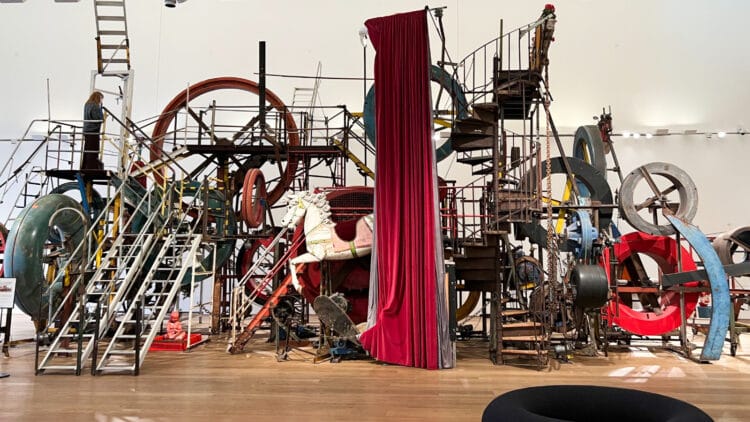
The Museum Tinguely in Basel is dedicated to Switzerland’s most unconventional modern artist, Jean Tinguely. Best known for his playful machine sculptures, he also created major collaborative projects with Niki de Saint Phalle and other avant-garde artists. Alongside noisy kinetic machines, the museum shows drawings, videos, and a quirky archive of letters and improvised postcards scrawled on scraps of cardboard or napkins. Visitors can enjoy his whimsical fountains outside the museum and near Basel’s art museum.
Tinguely Museum Basel Highlights
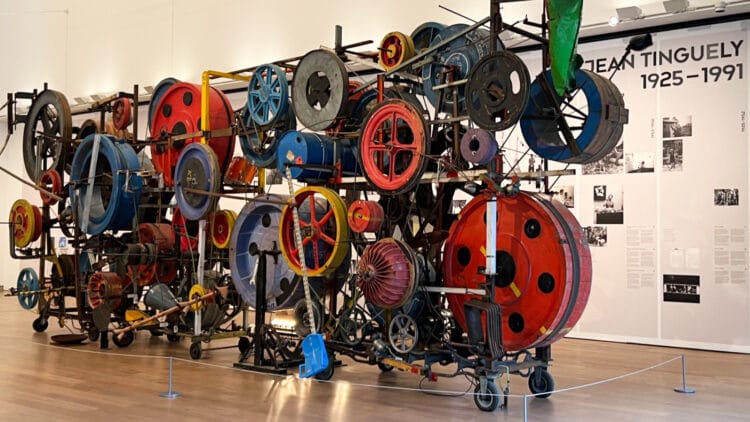
The museum holds the world’s largest Tinguely collection: about 130 sculptures and 2,000 works on paper. Around half the galleries display the permanent collection, while the rest host changing exhibitions.
Born in Fribourg and raised in Basel, Jean Tinguely (1925-1991) turned machines into art that rattled, spun, and sometimes destroyed themselves. In 1950, he joined Nouveau Réalisme in Paris and worked closely with Niki de Saint Phalle. Humorous and satirical, his kinetic inventions made him a pioneer of modern art.
The Museum Tinguely is not just about viewing static objects — it’s about experiencing noise, movement, and humor. Machines clank into life, giant constructions play music, and even scraps of paper reveal creativity. Whether you’re drawn to kinetic art, curious about avant-garde collaborations, or simply looking for a unique Basel museum, this is a lively stop along the Rhine.
La roue = c’est tout
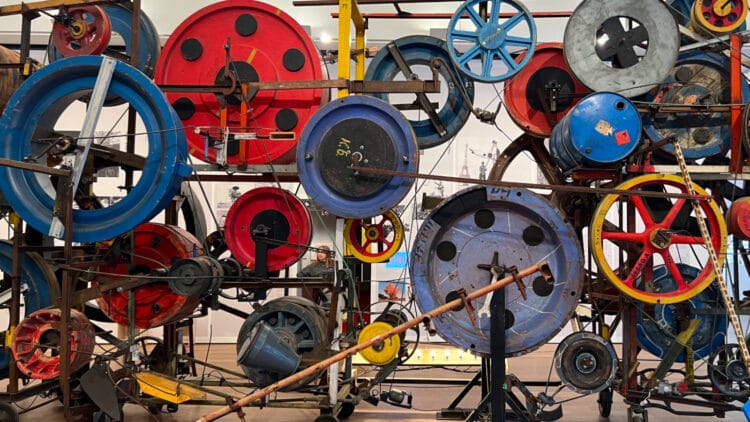
The current permanent exhibition La roue = c’est tout (The wheel = that’s all), on view until at least 2026, traces Tinguely’s career from the mid-1950s onward.
- Many machines are still functional, activated by buttons or timed programs.
- Rest periods of 5–15 minutes protect the mechanisms; waiting times are shown on screens.
- Noise is part of the experience — this is not a hushed gallery.
Smaller rooms explain designs, projects, and collaborations, often with Niki de Saint Phalle. Displays of his correspondence reveal how he turned everyday scraps into art.
Videos add context, including Homage to New York (1960), a giant self-destructing machine built in the MoMA sculpture garden. Surviving fragments, including Homage to New York (Klaxon), are on view in Basel.
Tinguely’s Love of Fast Cars and Racing
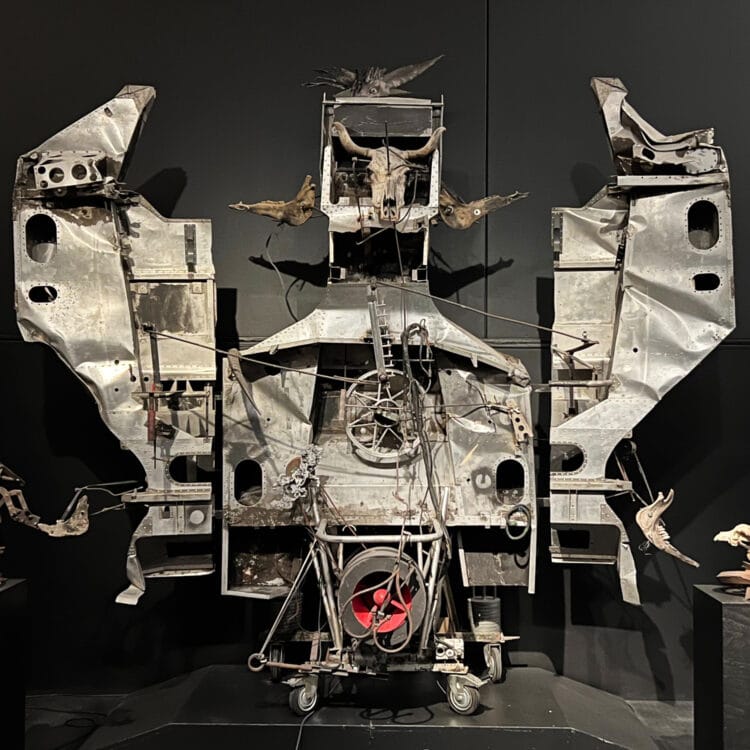
Tinguely loved car racing, especially Formula 1, and called cars the most beautiful artworks in the world. Several pieces memorialize the deaths of racing friends in the dangerous 1960s and 70s.
- Lola T180 – Mémorial pour Joakim B. (1988), a winged altarpiece made from two racing chassis, commemorating Swedish driver Joakim Bonnier.
- Schreckenskarrette – Viva Ferrari (1985), an iron car inspired by ancient chariots.
His first wife, Eva Aeppli (1925-2015), made Fünf Witwen (Five Widows, 1969). This sad work is often considered a memorial for the racing drivers, including Tinguely’s close friends Jim Clark, Jo Siffert, and Bonnier.
Large Music Machine Sculptures
The museum’s final hall is the most impressive. Here, several giant works show Tinguely’s obsession with sound, rhythm, and spectacle:
- Grosse Méta-Maxi-Maxi-Utopia (1987) was originally built for his Venice retrospective. Visitors can climb inside and walk through while it runs — risky, noisy, unforgettable.
- Méta-Harmonie II (1979) is a vast music machine that erupts every hour on the dot.
Visiting the Museum Tinguely is not just about viewing static objects — it’s about experiencing noise, movement, and humor. Machines clank into life, giant constructions play music, and even scraps of paper reveal creativity. Whether you’re drawn to kinetic art, curious about avant-garde collaborations, or simply looking for a unique Basel museum, this is a lively stop along the Rhine.
Visit the Museum Tinguely in Basel
Opening Hours
Tuesday–Sunday: 11:00–18:00. Thursdays open until 21:00.
Closed Mondays and on December 25.
Tickets
Adults CHF18; students CHF12; children under 16 free. Free admission for all on Thursdays 18:00–21:00.
The BaselCard (50% off), Swiss Museum Pass (free), and Swiss Travel Pass (free) are accepted.
Buy tickets online or at the museum. Time-slot reservations are usually unnecessary.
Getting to the Museum Tinguely in Basel
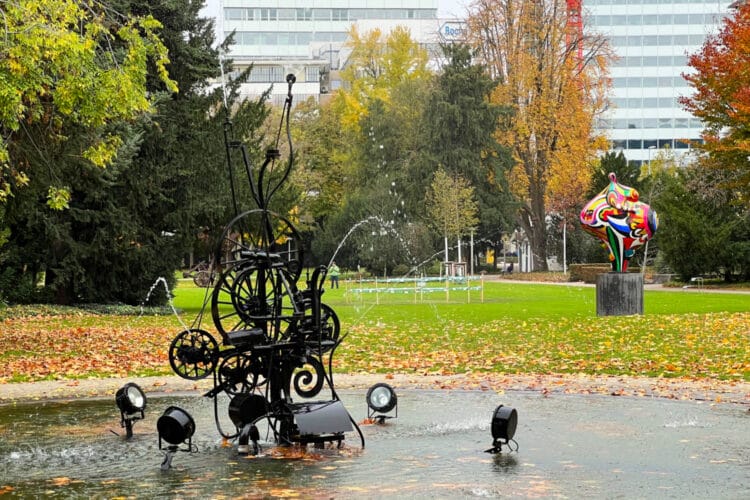
The Tinguely Museum is located at Paul Sacher-Anlage 1, 4058 Basel, in a park on the Rhine’s northern bank. Walking along the river from the city center is a pleasant option, with views of the Basel Minster towering over the city. From the Kunstmuseum and the Tinguely Carneval Fountain in the center, walking takes around half an hour.
Using public transportation to the “Tinguely Museum” bus stop:
- From Basel SBB (main station): tram 1 or 2, then bus 31 or 38 from Wettensteinplatz.
- From the city center: bus 31 or 38 from Schifflände or Claraplatz.
- From Badischer Bahnhof: bus 36 or a 15-minute walk.
- From EuroAirport Basel / Mulhouse / Freiburg: bus 50 to Basel SBB, then tram connections.
Basel hotel guests receive a BaselCard with free public transport and discounts on museums and other sights.
→ Elsewhere in Switzerland, the much smaller Espace Jean Tinguely Niki de Saint Phalle in Fribourg (Freiburg) displays around ten large moving sculptures and a few smaller items by both artists.